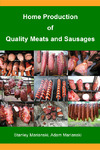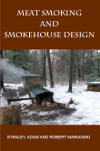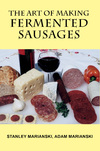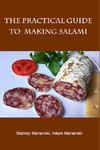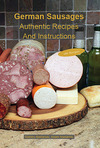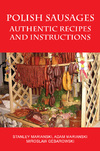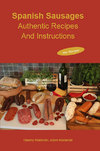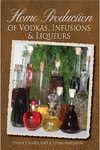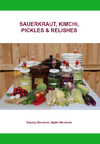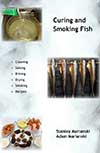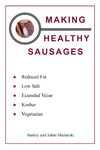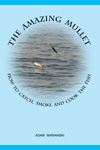Meats and Sausages
Curing Meats with Celery Juice Powder
Conventional curing with nitrates/nitrites.
We have been using nitrates for thousands of years. How did we discover nitrates is a matter to speculation, they were most likely discovered by accident by the use of salt that happened to be contaminated with potassium nitrate (commonly known as saltpeter, one of the three ingredients that was used for making gunpowder). We did not know why, but we knew that meat treated with certain salts retained a red color, developed a characteristic taste and lasted longer. Later, we discovered that meat treated with nitrates was less susceptible to contamination with disease-causing bacteria, particularly the very dangerous Clostridium botulinum, also known as food poisoning bacteria.
By the 1980s it became apparent that meat contained certain bacteria that were capable of converting nitrates into nitrites and that nitrites were the agents that were responsible for changing the characteristics of meat, which is described today as “curing.” To cure means to add nitrite and/or nitrate with salt to meat to preserve it. If only salt is added, the meat is just salted and not cured. Sodium nitrite is a safe, government-approved ingredient that gives cured meats their characteristic color and flavor.
In the 1970’s it was discovered that frying bacon on high heat can form carcinogenic nitrosamines, which might be detrimental to our health. This created a lot of panic, and in the 1970s, there was extensive research about the harmful effects of nitrates on our health. Millions of dollars were spent, a lot of research was done, and many researchers had spent long sleepless nights seeking fame and glory, but no evidence was found that when nitrates are used within the established limits, they can pose any danger to our health. A review of all scientific literature on nitrite by the National Research Council of the National Academy of Sciences indicates that nitrite does not directly harm us in any way. To protect the customer, new nitrite limits were established and the new law prohibits adding more than 120 ppm (parts per million) of sodium nitrite to pork belly that will be processed into bacon. Adding nitrate to bacon is not allowed.
What was also discovered was that all that talk about the danger of nitrite in our meat pales compared with the amounts of nitrates found in vegetables that we consume every day. It is estimated that about 90% of all nitrates we acquire are from vegetables. (link) Nitrates are present in the soil in which vegetables grow, but they get even more nitrates from the fertilizers that are used in agriculture. Have you ever heard of ammonia nitrate fertilizer… everybody knows this name. Don’t blame sausages for the nitrates you consume; blame the farmer. Eating vegetables regularly is more dangerous to one's health than a sausage.
The invention of celery powder
At first glimpse, curing meats with celery powder instead nitrites seem a wonderful idea, however, celery and other vegetables contain the same nitrate that we have been adding to meats for centuries. It is simply a different way of packaging nitrate. To expand sales, producers came up with a variety of “natural” and “organic” processed meats employing catchy slogans such as “no synthetic preservatives” or “no nitrites added.” Those phrases cannot replace the crucial role nitrites play in processed meats; they just replace the source of the nitrite. The latest fad of adding natural sources of nitrite to meat has little to do with protecting consumers; it is all about marketing a different product to make money. It is hard to blame an average consumer for believing that if the label says no nitrate/nitrite added, the product is healthier. However, there is another sentence on the label marked with an asterisk * which should be read as well: “no nitrites or nitrates added”: *except for those naturally occurring nitrates and nitrites in celery powder.
Currently USDA regulations require that meats cured with celery juice powder be called “uncured” to distinguish them from conventionally cured products. Labels of meats cured with celery powder often say “no nitrates or nitrites added,” but also contain a statement “other than those which naturally occur in celery powder.” This is a confusing statement because celery powder contains nitrite, and if nitrite is added the meat is de facto cured. It is like reading a legal contract, the most important information is hidden behind a small print.
Celery is rich in natural nitrate, and treating celery juice with a bacterial culture produces nitrite. The concentrated juice can then be added to produce “no nitrite added” meat. Celery powder is allowable as an organic ingredient, but what is interesting is that the celery itself does not have to be organic. Celery powder is made by dehydrating, concentrating, and grinding down the stalks of celery. Non-organic celery is ranked 11th on the Environmental Working Group’s Dirty Dozen list of vegetables that, when grown conventionally, absorb the highest levels of pesticides.
The official regulations state clearly that the traditional curing process requires the addition of nitrite and thus “organic” processed meats that are treated with celery juice must be labeled as “uncured.” A number of meat industry companies and meat associations have petitioned the United Stated Department of Agriculture asking for permission to use the word “cured” on the label, however, the USDA has been reluctant to do it so far, as they are still researching the influence of celery nitrite on the safety of the products. Nitrite gives meat not only their characteristic color and flavor, it also retards meat oxidation that leads to fat rancidity and inhibits the growth of pathogenic bacteria such as Listeria monocytogenes, Clostridium perfringens and Clostridium botulinum. Nitrite is the most effective agent to prevent spores of Clostridium botulinum, also known as food poisoning, from producing toxin, which is recognized as the worst toxin.
Nitrite, which is present in celery powder develops meat’s color and flavor, inhibits oxidation, but has not been determined yet how effective it is againstClostridium botulinum. This is the reason why the USDA is hesitant to use the term “cured” for meats that contain natural nitrite that is found in celery and other vegetables. Additional studies are needed to fully define the ability of natural cure ingredients to inhibit foodborne pathogens.
Why Celery
Vegetables that contain the most nitrite are spinach, beetroot, lettuces, celery, and then cabbages, potatoes, and carrots in smaller amounts. Some vegetables like beets and carrots have a lot of natural pigment and can affect the color of meat. Others have a stronger flavor and will leave a vegetable undertaste in meat. We could use beet juice to make hot dogs, however, the color will be unusual. After careful studies and trials, it has been determined that celery juice was most suitable for meat products as it did not alter the finished product flavor or appearance.
Conclusion
To sum it up “nitrite is nitrite” and it does not matter where it comes from. Nitrite hidden in celery powder, celery juice, or other vegetables is not healthier than conventional nitrite known as Cure #1, pink salt, or Prague powder #1 that we have been adding to meats. Saying “no nitrates or nitrites added, other than those which naturally occur in celery powder” is just a different way of packaging nitrite. The undisputed fact is that vegetables do contain nitrites, sometimes in lesser, sometimes in greater amounts than found in conventional products. That’s because the amount of nitrite that forms from nitrate in celery juice is difficult to evaluate, while in conventionally cured meats, the addition of nitrite can be precisely controlled.How much celery juice powder to add to meat is difficult to evaluate. Too much celery powder may induce vegetable flavor and aroma which may lead to a lower acceptance of the product, since most consumers will object to vegetable flavor in a sausage. Adding too little will not cure meat properly and may even create a safety hazard. It has been generally accepted that adding 0.2% - 0.4% celery juice powder to meat delivers satisfactory results. Recommended usage: 0.2% - 0.4% Celery Juice Powder of total weight of ground meat will bring sausage to 100 - 200ppm nitrite. Approximately 1 oz per 20 lbs. of meat.
“There is little evidence that preserving meats using celery … is any healthier than other added nitrites,” Dariush Mozaffarian, dean of the Friedman School of Nutrition Science & Policy at Tufts University, told New Food Economy. “Until industry provides strong evidence that nitrites in celery juice have different biologic effects than nitrites from other sources, it’s very misleading to label these [products] as ‘nitrite free’ or to consider such processed meats as being healthier.”


